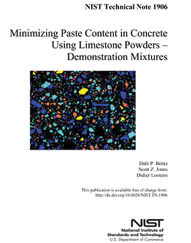Keen on lower carbon alternatives to portland cement-only binders, the U.S. Department of Commerce’s National Institute of Standards and Technology has published Technical Note 1906, Minimizing Paste Content in Concrete Using Limestone Powders — Demonstration Mixtures. Researchers cite target performance levels in concrete mixtures with up to 28 percent lower portland cement content using a binary blend with limestone powder.
Tested mixtures contained lower water content than portland cement-only controls, and attained adequate workability through the use of high range water reducing admixtures. Authors cite limestone powder as the primary source of calcium oxide in portland cement—a more abundant mineral than such supplementary cementitious materials as fly ash, slag, silica fume and metakolin. They present an approach to augmenting cement paste with appropriately graded limestone powder; it effectively extends utilization of centimeter-sized coarse and millimeter-sized fine aggregates that occupy between 65 percent and 75 percent of concrete matrix volume to include micro-aggregates in the 1- to 100-micrometer size range.
Demonstration paste, mortar and concrete mixtures of 0.40 or higher water-cement ratio were formulated with limestone powder replacement for a significant portion of their cement paste, achieving the cement reductions upward of 30 percent. Reasonable high range water reducer dosages allowed researchers to maintain specimens’ water-to-solids ratio in the 0.22 to 0.40 range, maximizing the limestone powder replacement level, while still providing sufficient flow and rheology.
|
|
| The report can be downloaded from www.nist.gov. On the cover is a color-coded scanning electron microscope/X-ray image of a 5:50:45 blend of fine limestone/cement/coarse limestone powder blend, captured from a 439- x 586-micrometer specimen. |
 |
| The Tech Note illustrates a two-dimensional slice from a three-dimensional model of spherical cement particles in water. Shades of blue indicate distances of water from the nearest cement particle (gray) surface—lighter blues indicating a greater distance. |
